5 New Patient Welcome Letters That Increase Patient Experience
Creating a welcome letter requires a bit of effort upfront but has an ever-lasting experience on how new patients perceive you. Here are 5 examples of new patient welcome letters.

Think about the last time you switched doctors. It’s a pretty nerve-wracking experience between evaluating alternative providers, selecting the right one, and switching over your information. What’s worse is walking into their doors for your first-ever appointment with them.
You want to feel accepted by the practice.
But if you selected a doctor or healthcare organization that also happens to focus on their patient experience, they sent you a new patient welcome letter and packet.
The letter is the first page and it expressed…
- How thankful they are for your business
- Information about their organization
The subsequent pages contain information regarding...
- Benefits that come with being a patient within their practice
- General information about work hours, appointments, and frequently asked questions
- How to make payment
- Medical history questions
All of the information is essential to running their practice but the first-page welcome letter is the most important piece.
If you’re a healthcare organization, you can’t ignore or overlook sending new patient welcome letter. Sure, the patient has already done their research by looking at the testimonials you’ve published online. But what you communicate to them on this cover page is the first true impression of your organization.
Since it only takes one-tenth of a second for patients to form a first impression, you’ll need to ensure that what you tell them is what they want to hear.
What to Include in Your New Patient Welcome Letter
Creating a welcome letter requires a bit of effort upfront but has an ever-lasting experience on how new patients perceive you.
While you’re creating your own, you’ll need to focus on the content within it and its overall design. That’s a lot of work if you don’t have anything to look at as a reference. Here are 5 examples of new patient welcome letters.
Georgia Memory Net
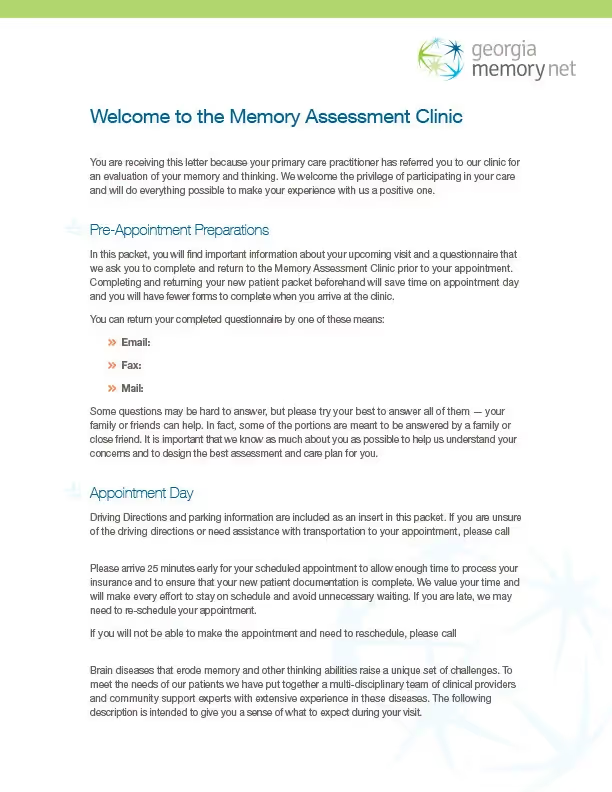
The three most important aspects that a new patient needs to know before coming to their first appointment is what to bring, what to expect and how to get there.
Georgia Memory Net accomplishes each of those within two sections on their one-page welcome letter.
But before we look at the content within those two sections, let’s look at their introduction paragraph.

The clinic uses a word choice that everyone can understand while efficiently explaining to the recipient why they’ve received the letter. But what’s most interesting about their introduction is how they’ve worded it.
They state that it’s a privilege to care for the new patient and that they’ll do everything possible to make their experience positive.

Their second section contains information about what the reader will find within the subsequent pages, why they’re there, and what to do with them.
It’s straight-forward and formatted in a way that isn’t overwhelming by using adequate whitespace.
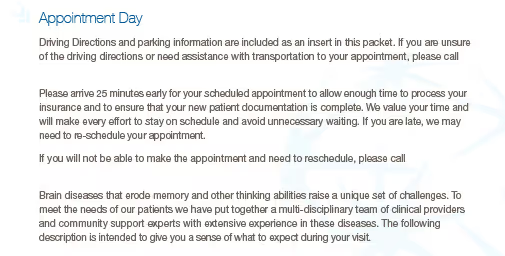
Finally, the third section of the new patient welcome letter tells the reader what to expect on their appointment day. The clinic details that they’ve included driving directions, when to show up, how to reschedule, and what they evaluate.
Precision Dermatology
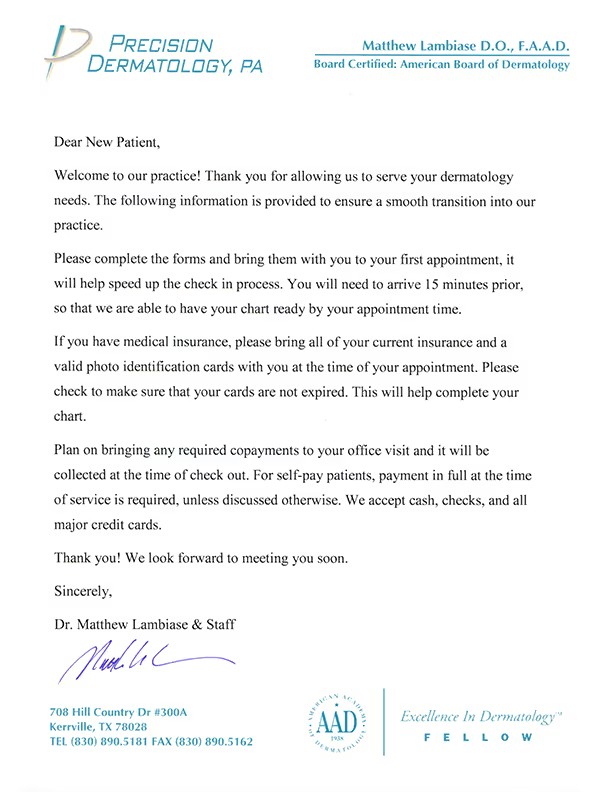
For some patients, receiving a welcome letter may spike their anxiety even more. Especially if it contains overly professional language.
Depending on your client demographic it may be better to use a more personal approach. Precision Dermatology achieves exactly that with what they send their new patients.
Instead of using an informational format, they’ve taken the terminology more literal by providing it as a memo. But outside of the content, what sets them apart is that their staff members sign each new patient correspondence.
It’s a simple gesture that goes a long way in making their clients feel welcomed.
Dental on Central
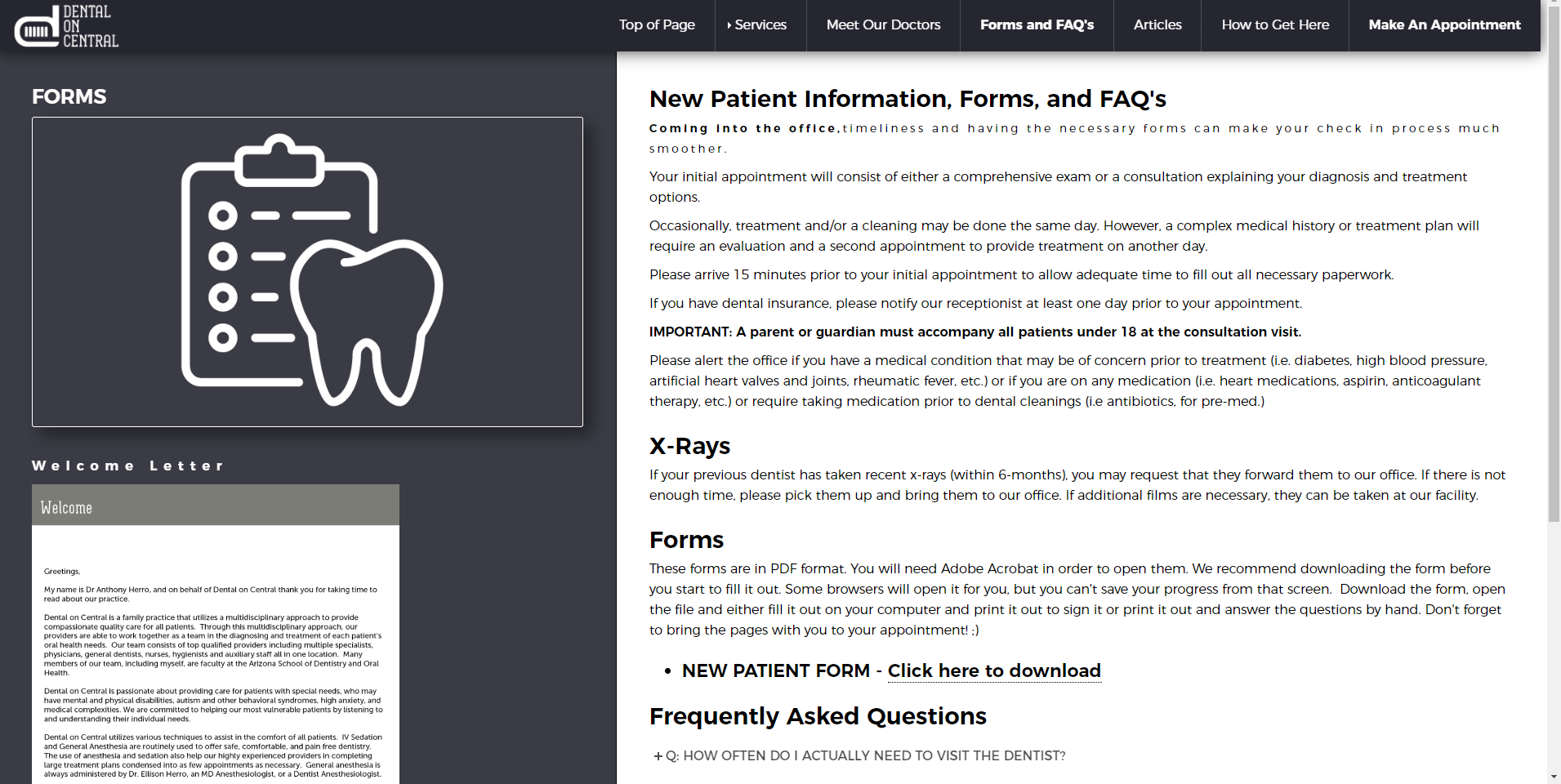
Dental on Central takes a modern approach in helping those who haven’t been to an appointment yet.
Within the Forms and FAQ’s section of their website, users can read everything they need to in order to prepare for their first visit. They can learn about what to expect, safety procedures, what to fill out, and download all documents in a fillable PDF format.
Some healthcare organizations send their welcome packets through the mail in order to save time. However, this can get expensive because as you add more content the packet’s weight will increase. As it gets heavier, your mailing costs will increase as well. This isn’t efficient for any sized practice.
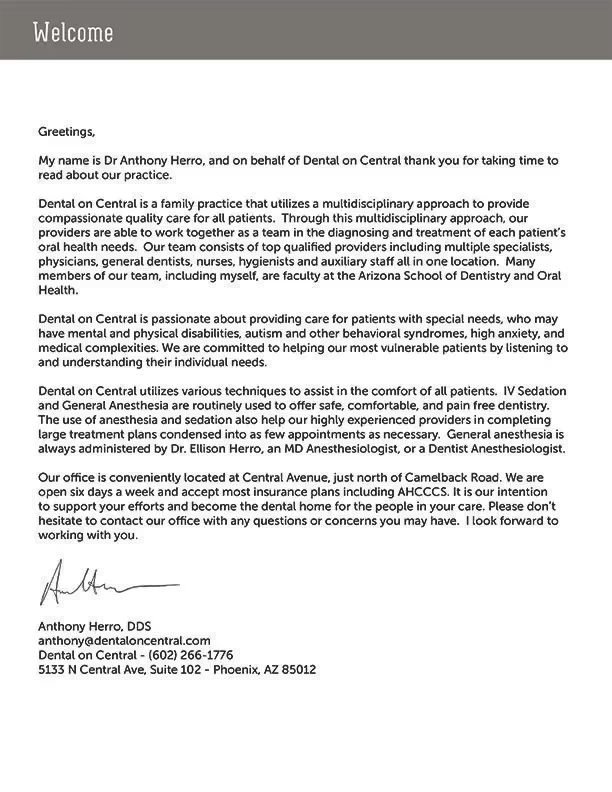
But by dedicating an area within your website to welcoming brand-new clients you’ll be able to cut down on mailing costs.
Instead of sending out a 10-page packet in a thick, bubble-wrapped envelope you’d only need to send the one-page welcome letter. Within it, direct readers to the devoted URL that contains your downloadable forms.
Trident General Dentistry
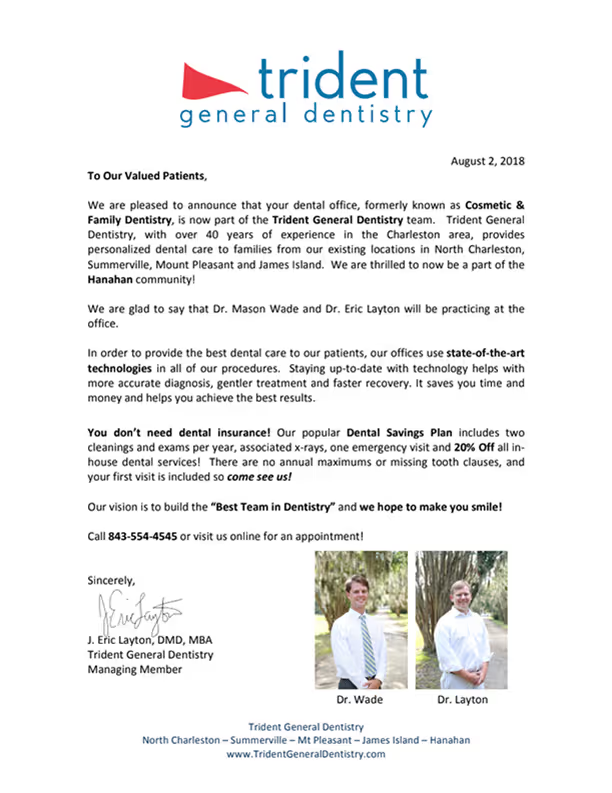
Cosmetic and Family Dentistry joined the Trident General Dentistry team back in mid-2018. As part of that, they sent out an announcement message to their patients.
While sending announcements and news about your organization to your patients is a best practice, it falls outside of this blog post. However, this example is a technically welcome letter from Trident General Dentistry to their new patients from Cosmetic & Family Dentistry.
This is a great example because it’s well-formatted, personal, and heartfelt. But what’s most unique is that they’ve provided pictures of the doctor’s mentioned from the small, transferring practice.
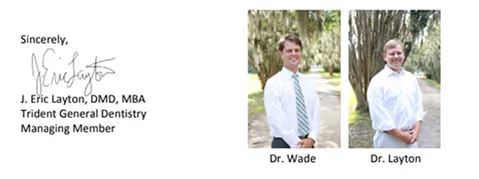
New Patient Welcome Email
As more practices move toward being 100% paperless offices, sending anything through the mail heads toward the wayside. Instead, all correspondence takes on an electronic format.
If you’re moving towards this business model, you won’t need to spend any of your time designing a letter. But that doesn’t mean you shouldn’t welcome new clients into your office with a personalized message. All that changes is the medium in which they’re sent.
Most patients actually prefer email. In fact, 93% are likely to actively select a physician who offers it as a communication method.
That statistic alone establishes the creditability of using a new patient welcome email over a letter.
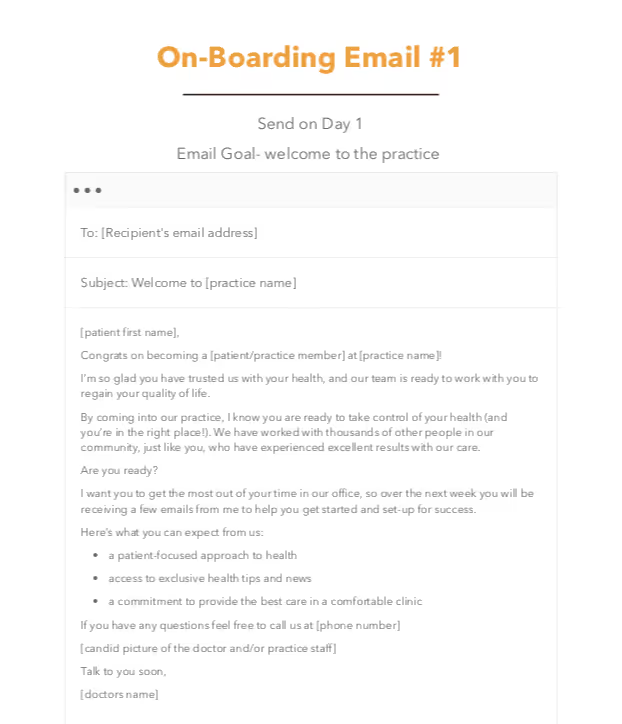
Of course, it’s all dependant on the type of patient that comes into your office. Although the majority of people use email regularly, certain age groups don’t use it as often as others.
But if you do decide to use emails instead of letters, you have to think about three things while drafting them…
- Brevity
- Spacing
- Personalization
First, being brief is important because people skim email messages. The average adult focuses on one task for eight seconds. So in order to have success with these emails, you’ll need to keep your readers in mind.
Second, spacing is important for that same reason as brevity; it helps cater to the skimming reader.
Third, personalization is key to successful new patient emails because it increases open rates by almost 30%. It practically guarantees that your patients will open your message.
Conclusion
Getting new patients to discover you is one of the hardest aspects of being a healthcare organization. But once you’ve started to receive them, you’re still not done. You’ll want to turn them into loyal clients and assure their best care.
Turning your new patients into your most loyal clients doesn’t happen overnight. But that can’t happen without spending time on your patient experience, which all starts with a new patient welcome letter. As well as address any privacy concerns they may have. Keeping protected health information is vital when onboarding new clients. Whether dealing with insurance information, payer portals, or medication lists, your company needs strong security policies in place.
Once you send it you’ll show them that you care about their business, decrease time spent in the waiting room, and increase your engagement.
Emphasize your product's unique features or benefits to differentiate it from competitors
In nec dictum adipiscing pharetra enim etiam scelerisque dolor purus ipsum egestas cursus vulputate arcu egestas ut eu sed mollis consectetur mattis pharetra curabitur et maecenas in mattis fames consectetur ipsum quis risus mauris aliquam ornare nisl purus at ipsum nulla accumsan consectetur vestibulum suspendisse aliquam condimentum scelerisque lacinia pellentesque vestibulum condimentum turpis ligula pharetra dictum sapien facilisis sapien at sagittis et cursus congue.
- Pharetra curabitur et maecenas in mattis fames consectetur ipsum quis risus.
- Justo urna nisi auctor consequat consectetur dolor lectus blandit.
- Eget egestas volutpat lacinia vestibulum vitae mattis hendrerit.
- Ornare elit odio tellus orci bibendum dictum id sem congue enim amet diam.
Incorporate statistics or specific numbers to highlight the effectiveness or popularity of your offering
Convallis pellentesque ullamcorper sapien sed tristique fermentum proin amet quam tincidunt feugiat vitae neque quisque odio ut pellentesque ac mauris eget lectus. Pretium arcu turpis lacus sapien sit at eu sapien duis magna nunc nibh nam non ut nibh ultrices ultrices elementum egestas enim nisl sed cursus pellentesque sit dignissim enim euismod sit et convallis sed pelis viverra quam at nisl sit pharetra enim nisl nec vestibulum posuere in volutpat sed blandit neque risus.

Use time-sensitive language to encourage immediate action, such as "Limited Time Offer
Feugiat vitae neque quisque odio ut pellentesque ac mauris eget lectus. Pretium arcu turpis lacus sapien sit at eu sapien duis magna nunc nibh nam non ut nibh ultrices ultrices elementum egestas enim nisl sed cursus pellentesque sit dignissim enim euismod sit et convallis sed pelis viverra quam at nisl sit pharetra enim nisl nec vestibulum posuere in volutpat sed blandit neque risus.
- Pharetra curabitur et maecenas in mattis fames consectetur ipsum quis risus.
- Justo urna nisi auctor consequat consectetur dolor lectus blandit.
- Eget egestas volutpat lacinia vestibulum vitae mattis hendrerit.
- Ornare elit odio tellus orci bibendum dictum id sem congue enim amet diam.
Address customer pain points directly by showing how your product solves their problems
Feugiat vitae neque quisque odio ut pellentesque ac mauris eget lectus. Pretium arcu turpis lacus sapien sit at eu sapien duis magna nunc nibh nam non ut nibh ultrices ultrices elementum egestas enim nisl sed cursus pellentesque sit dignissim enim euismod sit et convallis sed pelis viverra quam at nisl sit pharetra enim nisl nec vestibulum posuere in volutpat sed blandit neque risus.
Vel etiam vel amet aenean eget in habitasse nunc duis tellus sem turpis risus aliquam ac volutpat tellus eu faucibus ullamcorper.
Tailor titles to your ideal customer segment using phrases like "Designed for Busy Professionals
Sed pretium id nibh id sit felis vitae volutpat volutpat adipiscing at sodales neque lectus mi phasellus commodo at elit suspendisse ornare faucibus lectus purus viverra in nec aliquet commodo et sed sed nisi tempor mi pellentesque arcu viverra pretium duis enim vulputate dignissim etiam ultrices vitae neque urna proin nibh diam turpis augue lacus.


.avif)

